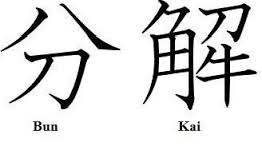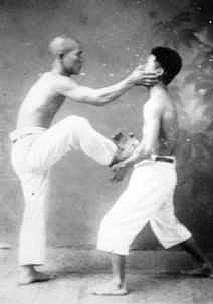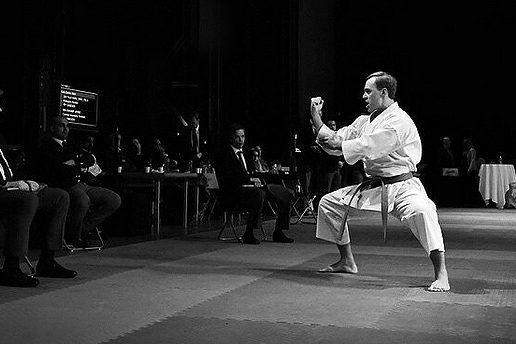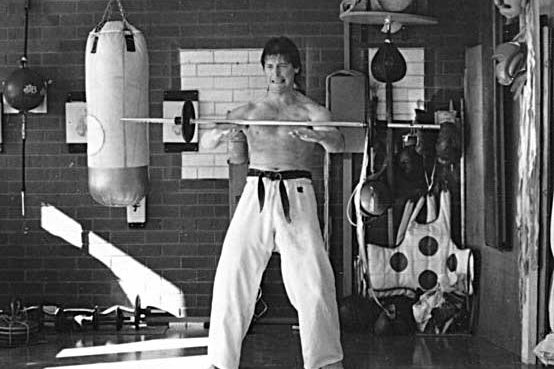Do you practice bunkai?
Some people say it’s the most important aspect of Karate.

Others say it’s a waste of time.
(Probably because it doesn’t result in getting shiny trophies.)
Anyhow, as a Karate Nerd™ you will probably encounter bunkai many times in your Karate journey.
- But what exactly is bunkai?
- Why is it important?
- And how do you do it?
This is what you’ll learn in todays’s article.
Check it out!
What is bunkai?
Bunkai is the practical application of kata.
The word itself actually means “to break down” in Japanese.
Here’s how it’s written:

When used in the context of Karate, bunkai symbolizes the whole process of breaking down the movements of a kata to understand how the techniques can be applied in self-defense.
In other words, bunkai is the essence of kata.
You see, kata was never meant to be used as a standalone solo exercise.
That’s a modern phenomenon.
Originally, kata was created as a memory tool – so you could practice various self-defense techniques used against a violent attacker on your own.
Sadly, the study of bunkai was dropped in the modernization of Karate.
That’s why kata training has been reduced to physical exercise in many dojos today.
(And if they do practice bunkai, it’s usually without any depth or enthusiasm – almost as an afterthought.)
Like putting the cart before the horse.
“You may train for a long time, but if you merely move your hands and feet and jump around like a puppet, learning Karate is not very different from learning a dance. You will never have reached the heart of the matter; you will have failed to grasp the quintessence of Karate.”
– Gichin Funakoshi (1868-1957)
Why is bunkai important?
Bunkai is important because it’s our #1 link to Karate’s functional origins.
You see, the original purpose of Karate was self-defense.
That’s it.
If you don’t understand this, you don’t understand Karate.
Karate was not created for sport, character building, fitness or McDojo business.
(Although today we use it in those ways, and many more.)
It was created for one purpose:
Self-defense.
These self-defense techniques were naturally practiced with a partner. But, as I mentioned before, in order to memorize and reinforce multiple self-defense sequences, you strung them together into longer sets called “kata”.
This is a learning technique called mnemonic device.
So, practicing kata without bunkai goes against the whole purpose of kata’s existence.
In a world where Karate is aiming for Olympic dreams, this fact is more important than ever. Bunkai is our last remaining connection to Karate’s original purpose and values.
Additionally, I think bunkai training can solve many people’s lack of motivation to practice kata.
I mean, if you don’t know the purpose of the techniques… what’s the point of doing them correctly?
“Kata without bunkai is like a shamisen (3 stringed Okinawan guitar); Nice sound, but empty on the inside.”
– Choki Motobu (1870-1944)
How do you practice bunkai?
Lastly, the fun part.
How do you practice bunkai?
By doing exactly what the word means: break down a kata.
The basic steps are:
- Choose a kata.
- Pick a sequence of the kata.
- Analyze the movements of that sequence.
- Apply the techniques in a self-defense scenario.
Sounds easy? It’s not…
This process of “reverse engineering” a kata is difficult for many people, because their limited ability to see kata as a pragmatic self-defense tool, rather than an abstract dojo dance, holds them back from realizing the true potential of kata’s practical applications.
That’s why I wrote a comprehensive guide called The Bunkai Blueprint and occasionally record bunkai videos for Karate Nerd Insider™.
Here’s a quick example:
At the end of the day, the #1 thing to keep in mind when doing bunkai is this:
The techniques should not be applied against “Karate attacks”.
Why? Because nobody will attack you with a perfect Karate punch/kick in a deep stance in reality.
A real life attack will be brutal, quick and unexpected.
That’s what your bunkai needs to work against!
Keep it realistic.
Good luck! ; -)
“Kata are not some kind of beautiful competitive dance, but a grand martial art of self-defense – which determines life and death.”
– Mabuni Kenwa (1889-1952)
To learn more about bunkai, check out these resources:
- The 3 Types of Bunkai (Omote, Ura & Honto)
- Karate Nerd Insider™
- 10 Videos from KNX15: The Karate Nerd Experience 2015
- 11 Useful Bunkai For The Kusanku Ninja Move
- The Bunkai Blueprint: A Simple Framework for Applying the Kata of Karate in Practical Self-Defense
- 7 Reasons Why Your Bunkai (Probably) Sucks
- 5 (More) Reasons Why Your Bunkai (Still) (Probably) Sucks
- 11 Practical Bunkai For Karate’s Jump Kick (Tobi-geri)
- Jesse’s Super Functional 4-Step Guide to Choosing the Right Kata for Your Next Bunkai Adventure
- 72 Bunkai to Juji-Uke (Cross Block)
- 58 Bunkai to Kakete
- Exclusive Interview: Iain Abernethy – UK’s Leading Expert on Practical Kata Bunkai
- 42 Bunkai to “Monk’s Salutation”



25 Comments